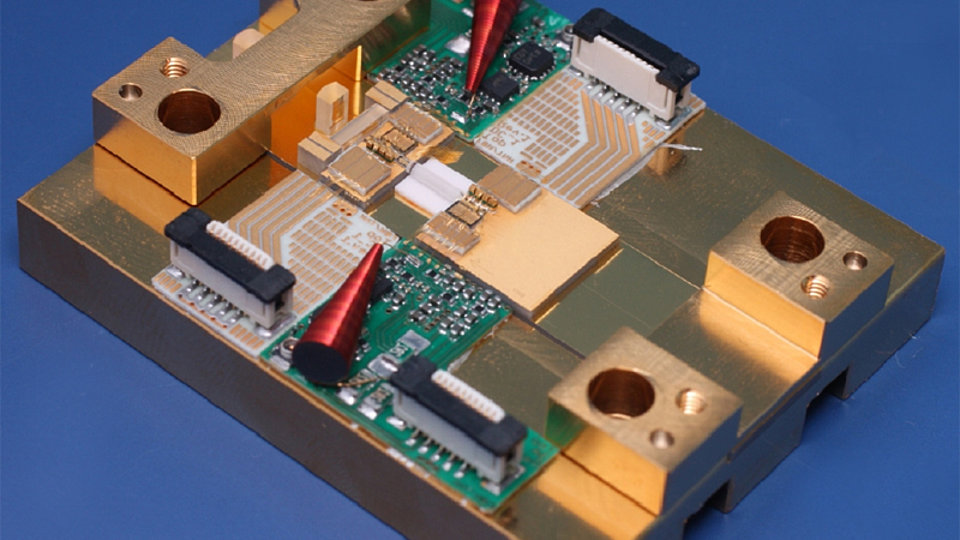Pulsed diode laser systems with high output powers and stabilized emission wavelength
Fig. 2: Magnified view showing the multi-section laser diode, graded-index lens, tapered amplifier and micro lenses at the output (from right)
Within the framework of the joint "FaZiT" project, the FBH develops pulsed diode-laser based systems for pulse durations in the time range from 100 ns down to 500 ps, in the range around 100 ps and below 10 ps. Due to their high optical output power of several tens of Watts and the stabilized emission wavelength they are ideally suited as seed lasers for pulsed fiber lasers. Their high market potential in materials processing, sensors and analytics (fluorescence spectroscopy) make these pulsed laser sources additionally attractive.
The laser diodes developed within the project are edge-emitters operating in the fundamental spatial mode with integrated wavelength stabilization (Bragg grating). The low beam divergence enables efficient coupling into single-mode fibers. In order to increase the pulse energy, amplifiers, also based on edge-emitters, are realized. The laser diodes and amplifiers are hybridly integrated together with micro lenses for optical-beam shaping on a microbench with a footprint of 4 cm x 5 cm. They are either assembled with electrical circuits (Fig. 1) based on GaN power transistors which have also been developed at the FBH or electrical power supply (Fig. 2).
The mounting of the components requires a precision in the sub-µm range. At first, the multi-section laser diode (2 mm) and the tapered amplifier (4 mm) are soldered on gold-plated carriers made from aluminum nitride ceramics. These subassemblies are then soldered together on a larger carrier of the same material. The radiation emitted by the laser diode is coupled by a 4.4 mm long graded-index lens into the amplifier. In order to keep the loss of radiation as low as possible, the laser diode and the amplifier must be adjusted to each other within a tolerance of 4 µm. After attaching the power supply lines, the coupling lens is adjusted and glued with a precision of 0.5 µm and better into all three spatial directions while operating the laser diode and the amplifier. The additional micro lenses at the output serve to transform the divergent radiation emitted by the amplifier into a collimated beam.
Figs. 3a and 3b show the temporal shape of the light pulses emitted by the diode laser system and the corresponding optical spectrum, respectively. The light pulses were generated by Q-switched operation of the laser diode where short electrical pulses switch a light absorbing section periodically transparent. The full width at half maximum of the light pulse is 80 ps and peak power amounts to 35 W. The optical spectrum shows a spectral line near 1067 nm. The spectral power density of the background caused by spontaneous emission is by a factor of 10,000 (40 dB) smaller than the power density of the line. These results have been achieved due to the integration of a Bragg grating into the multi-section laser diode, which successfully stabilizes the emission wavelength. Thus, FBH succeeded to develop tailored, miniaturized, pulsed diode laser systems for the desired applications by precision mounting of opto-electronic and optical devices on a joint platform.
Publication:
A. Liero, A. Klehr, S. Schwertfeger, T. Hoffmann, W. Heinrich, "Laser Driver Switching 20 A with 2 ns Pulse Width Using GaN", Vortrag International Microwave Symposium 2010, IEEE MTT-S Int.Microw.Symp.Dig., Anaheim, CA, May 25-27, pp. 1110-1113 (2010).
FBH research: 17.12.2010


